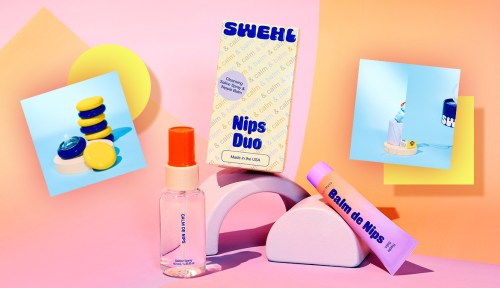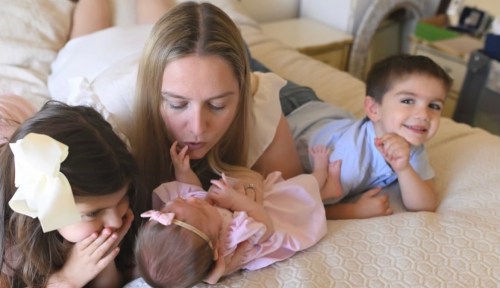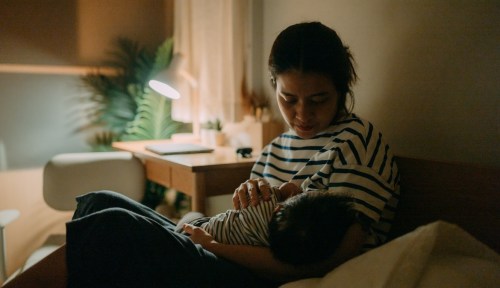The Founders of Swehl Want To Shrink the Huge and Long-Ignored Breastfeeding Learning Curve
New breastfeeding platform Swehl is reimagining the nursing experience with bite-sized video tutorials and multifunctional products.

Breastfeeding (or bodyfeeding or chestfeeding, as not everyone who body-feeds their baby has breasts) is regularly touted as the “best” way to nourish a newborn. The American Academy of Pediatrics (AAP) has long recommended exclusively feeding a baby human milk for the first six months of life, and a June 2022 update to its policy called for breastfeeding to be supported for two-plus years. Coupled with the fact that it’s a natural process, this sweeping praise for breastfeeding has spawned the misconception, among birthing parents and others, that it should always be the obvious, easy choice over formula-feeding. Which is part of the reason why, for many, the reality of how hard breastfeeding can be—physically, emotionally, and financially—may come as a shock.
Experts in This Article
It certainly did for Elizabeth Myer and Betsy Riley, co-founders of a new breastfeeding platform called Swehl. While embarking on their own breastfeeding journeys in 2020, both new moms felt isolated by the struggles they faced, only made worse by the false narratives that they should be breastfeeding, that it’s “free” and easy.
Born of their frustration with the notion that a person magically becomes a breastfeeding expert upon giving birth, Swehl is designed to clear the confusion, solve common challenges, and remind every new parent that they’re certainly not alone in their nursing experience.
To learn more about Swehl, directly from its co-founders Elizabeth Myer and Betsy Riley, listen to this episode of The Well+Good Podcast.
The current landscape of breastfeeding: rife with frustration and confusion
There’s no shortage of evidence pointing to the fraught relationship many birthing parents have with breastfeeding.
Back in 1991, the World Health Organization (WHO) and UNICEF teamed up to launch the “Baby-Friendly Hospital Initiative (BFHI)” to encourage health facilities to better support breastfeeding (in response to decreasing numbers of breastfeeding parents worldwide). The number of U.S. hospitals with a BFHI designation has grown notably since 2007, yet the program has had mixed results, at best.
A landmark 2013 study of more than 500 first-time mothers found that breastfeeding problems were a near-universal experience (92 percent of participants reported troubles at day three postpartum). And as it turns out, BFHI can actually backfire, in some instances. One of its primary tenants is the promotion of exclusive breastfeeding in hospitals and birthing centers immediately postpartum (and the coinciding restriction of formula), which can create undue stress among those who are struggling to breastfeed, making matters worse and putting the health of the baby and parent at risk.
Even those who receive the support they need from lactation consultants to breastfeed successfully post-birth may still face issues when they get home and in the weeks and months to follow, particularly when the realities of sleep deprivation, a baby’s growing nutritional needs, and obligations like work come into play.
While there’s a whole industry of products designed to solve for common breastfeeding struggles, navigating it is another story. Within about a month of having her first baby girl, Riley realized that she owned one of practically every one of these products—and yet, still felt no better about her ability to continue breastfeeding successfully.
“I took a road trip with my husband to visit family with my very small daughter, and as I was unpacking the car, I had this ‘a-ha’ moment of, ‘Oh my goodness, half my car is breastfeeding accessories.’” In addition to her hands-free pump and hospital-grade pump, she’d packed a nursing pillow, heating pads, and reusable milk containers; valves, flanges, and bottles; silver cups, syringes, and nipple everters—and the list goes on. “I realized I’d spent thousands of dollars on very hyper-medical tools, all from different companies,” says Riley. Worse yet, she hardly knew how to use any of this stuff.
“It became clear to me that the user journey around breastfeeding and how you get your information is totally broken.” —Elizabeth Myer, co-founder, Swehl
After all, the only way to learn would be to read lengthy user manuals…which wasn’t exactly feasible while she was tending to a newborn who was eager to eat, like, now. “You’re expected to become an expert overnight when you start breastfeeding, but you don’t have the resources to do so,” says Riley. Also personally familiar with this resources gap was Myer, who met Riley in a mom group and upon realizing she’d also acquired the same massive tangle of breastfeeding accessories, had her own lightbulb moment. “It became clear to me that the user journey around breastfeeding and how you get your information is totally broken,” she says.
If anyone would know, it was her. Myer had spent most of her career as a consultant in the brand-building and digital-marketing space for children’s products. “It took, on one side of my brain, years of research into the consumer mindset of moms, and on the other, actually becoming a mom, to realize that we are failing moms, especially in the first few months postpartum,” she says.
How Swehl is reimagining the breastfeeding ecosystem with streamlined products, video-based education, and talk circles
What Myer and Riley felt was most imminently missing from the mess of a breastfeeding industry they’d personally encountered was a one-stop shop. They needed one place where they could find products that were actually easy to use; quick, trustworthy solutions for their burning feeding questions; and a space to connect with other new parents who could relate. Swehl is designed to address all of the above by way of three pillars: education, product, and community.
Making information about breastfeeding easier to digest
The name Swehl, a twist on the word “swell,” references not only the swell of body parts (and of emotions) in the wake of new parenthood, but also the positive outcome of something splendid or excellent—á la, “That’s swell.” And the idea underscoring its conception is to help make breastfeeding a little more swell, without implying that breastfeeding is, or should be, the only option. “There’s a big spectrum of how you can feed your child, so what we want to do is arm parents with the resources and the confidence to make their own decisions,” says Myer.
“We wanted to eliminate hours of research and reading and avoid inundating someone who has just given birth with pamphlets.” —Myer
To do so, she and Riley first consulted with experts across the breastfeeding and chestfeeding space and recruited five of them to serve on Swehl’s advisory board, or “Motherboard:” an International Board Certified Lactation Consultant (IBCLC), an OB/GYN, a doula, a holistic nutritionist and postpartum doula, and a pediatrician. These experts, themselves, lead the brand’s 75-plus bite-sized videos (all of which are around three minutes or shorter) on all sorts of common feeding topics and concerns, including the basics (like how to spot hunger cues and the 101 on pumping) and the nitty-gritty (from how to utilize different feeding positions to how to deal with leakage and how to wean).
Eliminating the guesswork required to use breastfeeding products
The same video library also has brief video tutorials for each of Swehl’s breastfeeding products, which are currently packaged in a kit ($100): a reusable colostrum syringe and container, nipple shields (for a baby learning to latch), milk collection cups, nipple balm, a cleansing nipple saline spray, and a supplemental nursing system (for babies with a diagnosed latch issue). “We paired each of these products with a QR code that drives right to that expert-led video, which we thought was really important,” says Myer. “We wanted to eliminate hours of research and reading and avoid inundating someone who has just given birth with pamphlets.”
The products themselves reflect careful innovation, too, and not just in how they look (though that’s pretty swell, as well). Each was designed to work more smoothly than its preexisting counterpart, to be multifunctional, and to have a use-case beyond the breastfeeding days.
Just take the syringe. Typically, you might buy a pack of, say, 50 single-use plastic syringes to feed a baby with a poor latch, whereas Swehl’s syringe is made of reusable food-grade silicone. The other syringes also tend to shoot milk or formula directly into the back of a baby’s mouth (rather than between their gum and cheek or onto their tongue), which leaves ample room for user error. Swehl’s syringe, by contrast, has a Y-tip on the end, “designed to shoot the milk down either side of the baby’s throat, so there’s less of a choking risk,” says Myer. This tool can also be repurposed for use with a newborn medication, like gas drops or infant Motrin, whenever that might be necessary.
Another example? Swehl’s Cloud 9 nursing sling (sold separately from the kit for $65). An answer to bulky, cumbersome nursing pillows that are difficult to take on-the-go, the nursing sling is a sling bag with an adjustable strap that also has a built-in pillow you can use to cradle a baby’s head while breastfeeding, says Riley. “And when you’re done with your breastfeeding journey, you can just remove the pillow and have extra space in your sling bag.”
Centering community and connection along the breastfeeding journey
To ensure these products would fit seamlessly into a new parent’s lifestyle (both now and in the future), Riley and Myer didn’t just consider their personal pain points; they also tapped lots of other new parents, arranging focus groups where people could air their concerns. Participants responded so positively to the opportunity to connect with other new parents and share common nursing gripes and milestones that Riley and Myer decided to make these virtual talk circles a permanent part of Swehl.
At launch, the single-topic Zoom groups, capped around 10 people, will be led by one of the experts on Swehl’s Motherboard or another expert, celebrity, or influencer in the parenting space, depending on the topic (which will always revolve around something in the fertility, parenting, or postpartum space). “This person will kick off the session with a prompt, answer the prompt, and then open the floor for everyone else to respond,” says Myer. This way, everyone knows what they’re getting into when they commit to join, and everyone can feel like they have the chance to chime in (though there’s no pressure to do so, either).
There’s also the opportunity to either request a talk circle on a particular topic—for which Myer and Riley will find a host and set it up—or volunteer to host one of your own, using Swehl’s infrastructure.
The idea is for the talk circles to be a safer, more personable, and more helpful alternative to online parent forums for anyone on the new-parent journey (breastfeeding or otherwise) looking to connect with others in the same boat. According to Myer and Riley, the upsides of building such a community can’t be overstated. “Our first support group we ever did was lightning in a bottle,” says Myer. “Ultimately, we determined that the kind of emotional support you can get from connecting with those who are in it alongside you isn’t just a nice-to-have. It’s a must-have.”
To learn more about Swehl’s work in creating community, providing digestible information, and streamlining products surrounding breastfeeding, listen to the full podcast episode here.
Sign Up for Our Daily Newsletter
Get all the latest in wellness, trends, food, fitness, beauty, and more delivered right to your inbox.
Got it, you've been added to our email list.










